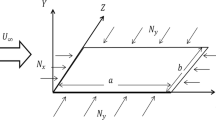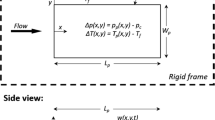Abstract
Focusing on the aeroelastic stability of thin panel structure of airframe component such as engine nozzle of high-speed flight vehicles, a nonlinear aeroelastic model for a two-dimensional heated panel exposing both surfaces to the airflow with different aerodynamic pressures is established. The von Karman large deflection plate theory and the first-order piston theory are used in the formulation of aeroelastic motion. The critical conditions for aeroelastic stability and the stability boundaries are obtained using theoretical analysis and numerical computations, respectively. The results show that the panel is more prone to become unstable when its two surfaces are subject to aerodynamic loading simultaneously; only if the sum of the aerodynamic pressures on both surfaces of the panel satisfies flutter stability condition, can the panel be likely aeroelastically stable; compared with the general panel flutter problem that only one surface is exposed to the airflows, the present condition makes the panel become aeroelastically unstable at relatively small flight aerodynamic pressure.
Similar content being viewed by others
References
Dowell E H. Aeroelasticity of Plates and Shells. Leyden: Noordhoff International Publishing, 1975
Dowell E H. A review of the aeroelastic stability of plates and shells, AIAA, 1970, 8(3): 385–399
Gray F E Jr, Mei C. Finite element method for large-amplitude two-dimensional panel flutter at hypersonic speeds. AIAA J, 1991, 29(2): 411–488
Cheng G F, Mei C. Finite element modal formulation for hypersonic panel Flutter analysis with thermal effects. AIAA J, 2004, 42(4): 687–695
Guo X Y, Mei C. Application of aeroelastic modes on nonlinear supersonic panel flutter at elevated temperatures. Computers & Structures, 2006, 84(24–25): 1619–1628
Xia W, Yang Z C. Stability analysis of heated panels in supersonic air flow (in Chinese). Chin J Theor Appl Mech, 2007, 39(5): 602–609
Xia W, Nonlinear flutter of heated composite panels in supersonic airflow (in Chinese). Doctoral Dissertation. Xi’an: Northwestern Polytechnical University, 2008
Yang Z C, Yang F, Zhang L L. Flutter suppression for sandwich panel using dynamic absorber (in Chinese). J Vib Shock, 2009, 28(7): 65–69
Ye X H, Yang Y R, Xiao Y P. Dynamic response of three-dimen-sional panel with thermal effect to atmosphere turbulence (in Chinese). Eng Mech, 2009, 26(6): 233–237
Ye X H, Yang Y R, Fan C G. Nonlinear flutter analysis of panel with thermal effect(in Chinese). Chin J Comput Mech, 2009, 26(5): 684–689
Yang C, Li G S, Wan Z Q. Aerothermal-aeroelastic two-way coupling method for hypersonic curved panel flutter. Sci China Tech Sci, 2012, 55: 831–840
Wang X Q, Han J L, Yun H W. Problem with panel flutter and its optimization design in yaw maneuver flight (in Chinese). J Astronaut, 2011, 32(2): 255–230
Li C G, Fu H Z, Yu Q. Aerospace Materials (in Chinese). Beijing: National Defense Industry Press, 2002
Author information
Authors and Affiliations
Corresponding author
Rights and permissions
About this article
Cite this article
Zhou, J., Yang, Z. & Gu, Y. Aeroelastic stability analysis of heated panel with aerodynamic loading on both surfaces. Sci. China Technol. Sci. 55, 2720–2726 (2012). https://doi.org/10.1007/s11431-012-4942-2
Received:
Accepted:
Published:
Issue Date:
DOI: https://doi.org/10.1007/s11431-012-4942-2




